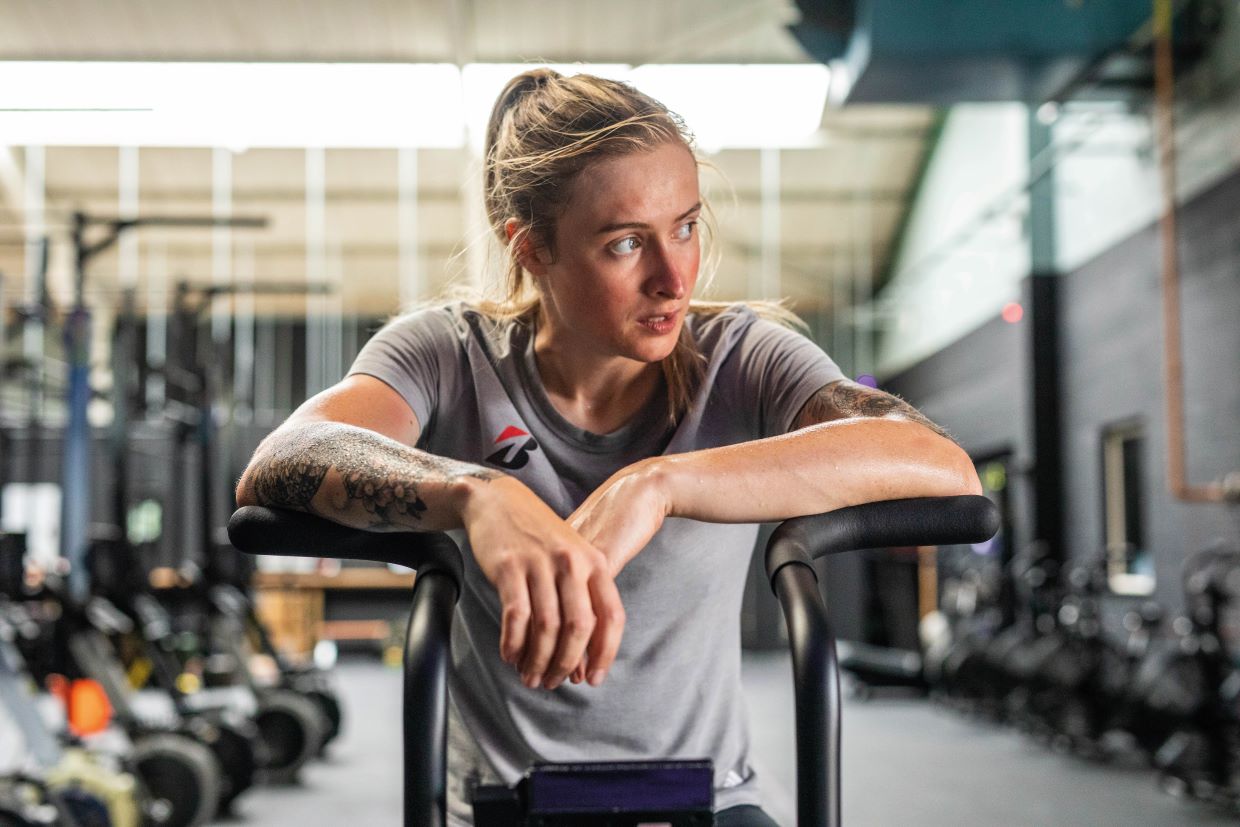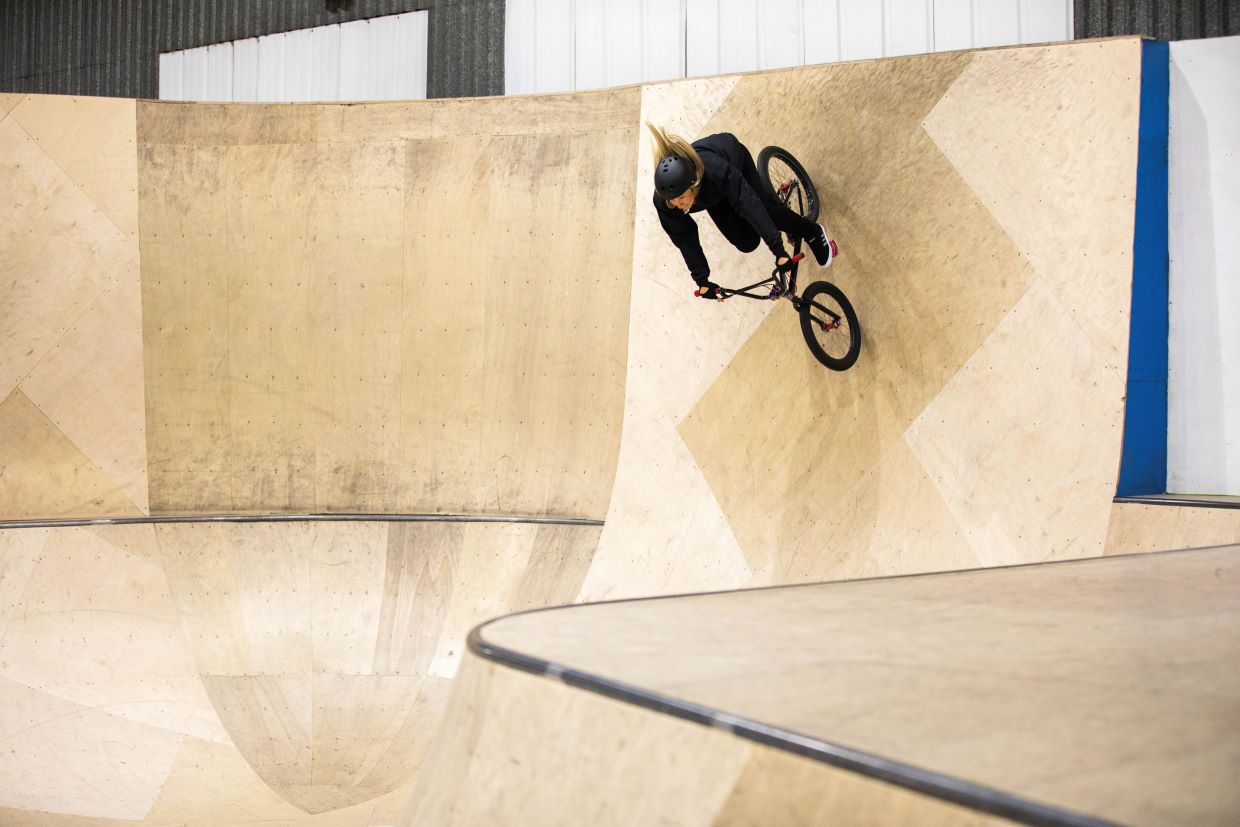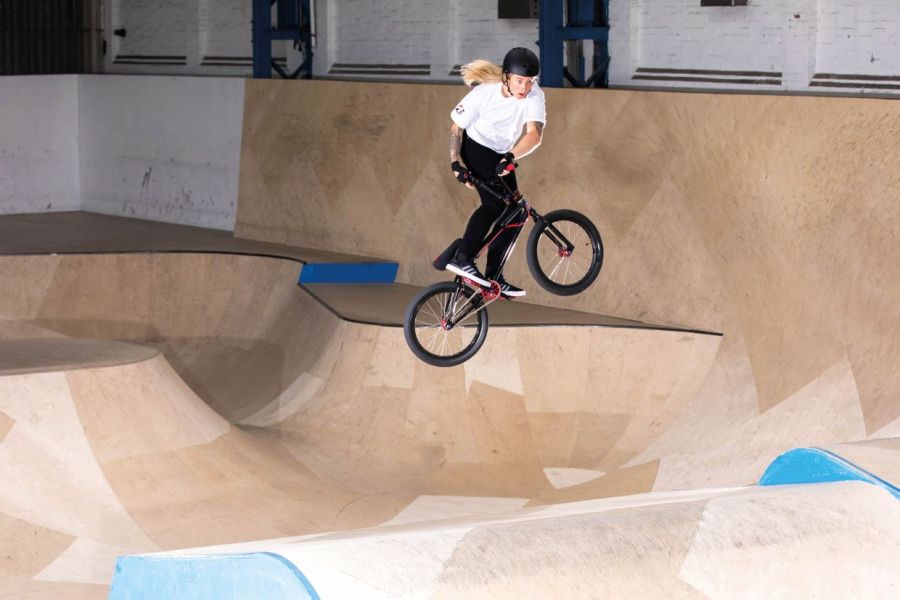Freestyle BMX athlete Charlotte Worthington became the first-ever British woman to win a world medal in the discipline at the 2019 UCI Urban Cycling World Championships. She went on to win gold at the 2020 Tokyo Olympics and became the first woman in history to land a 360-degree backflip in competition. Here, she tells us all about her BMX journey so far…
Charlotte Worthington on her BMX journey
‘I tried every sport going as a kid, although I preferred activities involving wheels and an element of danger, such as roller blading. The first time I tried using a stunt scooter at a skatepark, I stood at the edge of a ramp for about 15 minutes, absolutely petrified to go down. But then I did it, got the adrenaline rush and the gratification, and that’s what hooked me on scooters.
‘I was surrounded by BMX as a teenager and got a bike for my 15th birthday, but I couldn’t throw it around like a scooter, so it wasn’t as much fun. My feelings changed, however, when I was 19 and working full-time in a kitchen. I’d been over-riding my scooter and wanted something refreshing that offered that same level of adrenaline addiction.
‘BMX took over and, after a few competitions, I got noticed by British Cycling. They brought me in on the selection camp and gave me the opportunity to go all in on BMX Freestyle, even though it hadn’t been made an Olympic sport at that time. I won the nationals and European Championships in 2019 before going to the US to compete, so I only had two years of competition experience before the 2020 Tokyo Olympics took place.’
Related: CrossFit athlete Lucy Campbell shares her training secrets
What skills do you need as a BMX freestyler?
‘You have to be an all-rounder to be a BMX freestyler. It’s not about getting the fastest time, it’s a judged sport and your overall score is based on many factors, including difficulty, height, landings, originality and your use of the course. Each run you get in competition is one-minute long, so you need the stamina to go at max effort for 60 seconds while doing your tricks, plus the strength and agility to control the bike and your balance under fatigue.
‘I have no more than one rest day a week, usually on a Saturday or Sunday, and I take a mid-week break from BMX on Wednesdays and hit the gym, instead. BMX Freestyle is a creative sport, and it can be mentally fatiguing to go to the same skatepark and look at the same ramps. After three days in a row, my brain gets scrambled!
‘My skatepark sessions are two-to-three hours long, and much of it is based on neurological skills, muscle memory and repetition of tricks in the foam pit or on the resi ramps (surfaces that are hard enough to ride on but have some springiness to reduce impact). Falling is part of the sport, and fear is BMX, so you need to find the right balance between being so terrified of something that you freeze and make mistakes, and being too chilled that you take your eye off the ball.’
Related: Beginner to 50K: 8-week cycling training plan

Do you do any strength training?
‘Because BMX Freestyle isn’t about who’s fastest or strongest, my training isn’t a simple equation of “power + gym = winning”. I’ve figured out what I need and, due to shoulder injuries, I’ve been working heavily on my upper body. I’m in the gym four times a week to do high-repetition weights plus cardio on an assault bike, plus two longer cardio sessions on the road or indoors to work on endurance.
‘Core is also a huge part of BMX. When you’re throwing a bike around in the air, it’s how you keep it close to you to maintain control. I’ll pick four exercises, such as hollow rocks and plank hip dips, and do 3 x 20 reps of each.’
Tell us about your nutrition and vital kit.
‘When I first started out, I would power a BMX session on an energy drink and chocolate after a 12-hour shift in the kitchen. These days, I take my nutrition very seriously by eating lots of grains, vegetables and protein.
‘Don’t get me wrong, I’m a total foodie and have a terribly sweet tooth. But I really feel it the next day if I’ve had a few glasses of wine and carbs on a night out. I love the clean way I eat now, and I feel so much better for it.
‘In terms of kit, my helmet is vital, but shin pads are also very important because, if your foot slips off a BMX pedal, you’re likely to get pedal-to-the-shin, and I’ve got too many scars from that. My go-to footwear is the Adidas Originals Busenitz Vulc 2.0 shoe (£75) for the connection it provides between my feet and the bike via the pedals. Oh, and I wear a shoulder brace – that’s pretty vital!’
Related: Best cycling clothing and kit for women in 2023

What’s your greatest achievement to date?
‘It has to be winning gold at the 2020 Tokyo Olympics, not just because of the moment but because of the preparation, hardship and lessons I had to learn over the previous year to make me the person I needed to be. After dislocating my shoulder for the third time six weeks before the Games, I had a hectic 10-12 days of rehab to get my shoulder moving again, and I had to wear a shoulder brace in the final, so I definitely didn’t think I’d be winning gold.
‘Looking ahead to Paris 2024, I need to make sure I cover all bases in training and leave no stone unturned. That’s why I’m excited to be a part of Bridgestone’s Prepare to Perform Olympic campaign, because its message is about relying on the dedication of gruelling hard work to prepare, not luck. Physically, I think I’m there, but I think a lot of the challenge will be mental.’
Bridgestone, a global leader in tyres and sustainable mobility solutions, is proud to be a Worldwide Olympic and Paralympic Partner through 2024. Bridgestone celebrates the hard work and dedication of athletes on their journey to the Games, supporting them to prepare to perform on their journey towards Paris 2024*.
Words: Joanna Ebsworth | Photography: Bridgestone | *Olympians don’t rely on luck. Instead, they rely on dedication, gruelling hard work and years of preparation. Just like Bridgestone, they don’t take chances with safety, innovation or performance.







